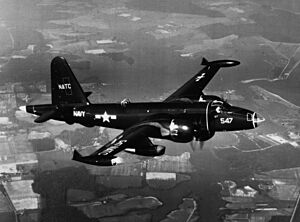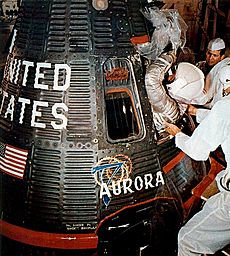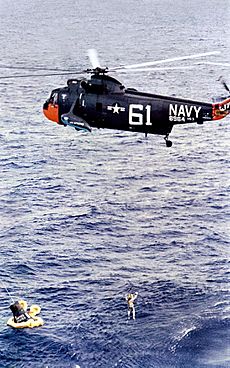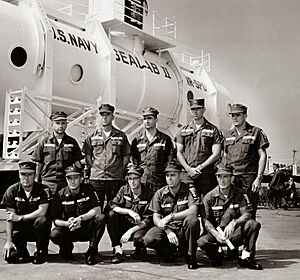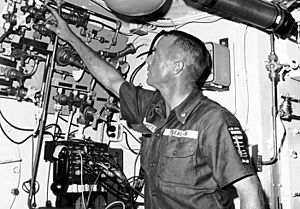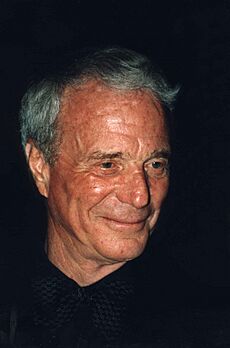Scott Carpenter facts for kids
Quick facts for kids
Scott Carpenter
|
|
|---|---|
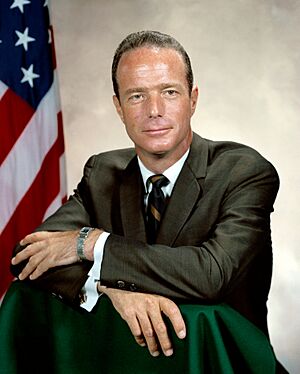
Carpenter in 1964
|
|
| Born |
Malcolm Scott Carpenter
May 1, 1925 Boulder, Colorado, U.S.
|
| Died | October 10, 2013 (aged 88) Denver, Colorado, U.S.
|
| Awards | Legion of Merit Distinguished Flying Cross NASA Distinguished Service Medal |
| Space career | |
| NASA astronaut | |
| Rank | Commander, USN |
|
Time in space
|
4h 56m |
| Selection | NASA Group 1 (1959) |
| Missions | Mercury-Atlas 7 |
|
Mission insignia
|
 |
| Retirement | August 10, 1967 |
Malcolm Scott Carpenter (born May 1, 1925 – died October 10, 2013) was an amazing American who achieved many things. He was a naval officer, a pilot, a test pilot, an engineer, an astronaut, and even an aquanaut. He was one of the first seven astronauts chosen by NASA for Project Mercury in April 1959.
Scott Carpenter made history as the second American, after John Glenn, to orbit the Earth. He was also the fourth American to travel into space, following Alan Shepard, Gus Grissom, and John Glenn.
In 1949, Carpenter joined the U.S. Navy. He became a naval aviator, flying Lockheed P-2 Neptune planes. He flew important missions to gather information and protect against submarines during the Korean War and the Cold War. In 1954, he trained at the U.S. Naval Test Pilot School and became a test pilot, flying many different types of aircraft.
A few years later, Carpenter was chosen as one of the famous Mercury Seven astronauts. He was the backup pilot for John Glenn's historic orbital mission. Carpenter then flew the next mission, Mercury Atlas 7, in his spacecraft, which he named Aurora 7. During his flight, some equipment didn't work perfectly, causing his spacecraft to land about 250 miles (400 km) away from its planned spot. Luckily, both Carpenter and his spacecraft were safely found and brought back.
In 1964, Carpenter took a break from NASA to join the U.S. Navy's SEALAB project. This project involved living underwater for long periods. During his training, he had an accident that caused injuries, meaning he couldn't go to space again. In 1965, he spent 28 days living on the ocean floor off the coast of California as part of SEALAB II.
After his underwater adventures, he returned to NASA to help with astronaut training. He later joined the Navy's Deep Submergence Systems Project in 1967. He retired from NASA in 1967 and from the Navy in 1969, holding the rank of commander. After his military career, Carpenter became a consultant for sports and diving companies. He also worked with the film industry on topics related to space and the ocean. He gave many talks and appeared in TV shows.
Contents
Scott Carpenter: Astronaut and Aquanaut
Growing Up in Colorado
Malcolm Scott Carpenter was born on May 1, 1925, in Boulder, Colorado. His father, Marion Scott Carpenter, was a research chemist, and his mother was Florence Kelso. As a child, he was known as Bud or Buddy. When he was very young, his family moved to New York City for his father's work.
In 1927, his mother, who was ill, returned to Boulder with Scott. She recovered over time and later became a chief medical librarian. Scott lived with his grandparents in Boulder. He went to University Hill Elementary School and Boulder High School. He was also a Boy Scout.
Like many young people in Boulder, Scott was greatly affected by the attack on Pearl Harbor, which led the United States into World War II. He decided he wanted to become a naval aviator, a pilot for the Navy. In 1943, he applied to join the Navy's aviation training program.
The Navy had many young men wanting to become pilots, so they created a program where cadets could attend college first. Scott went to Colorado College and then had flight training. The war ended before he finished his full training, so he was released from active duty in 1945.
After the war, Carpenter returned to the University of Colorado to study aeronautical engineering. He was injured in a car accident in 1946. He also famously missed a final exam because a bridge was washed out, leaving him one requirement short of his degree at the time.
Carpenter met Rene Louise Price, a fellow student, and they married in 1948. He joined the Navy again in 1949, and through an oversight, the Navy thought he had already earned his degree. He completed his flight training and became a naval aviator in 1951. He chose to fly multi-engine patrol aircraft, which were considered less dangerous than jet fighters, because he was a husband and father.
Becoming a Test Pilot
Carpenter was assigned to Patrol Squadron 6 (VP-6) in Hawaii. He flew reconnaissance and anti-submarine missions from Japan during the Korean War. These missions could be risky; one of his squadron's planes was shot down in 1951. He also flew surveillance missions along the coasts of the Soviet Union and China.
Because of his excellent performance, Carpenter was recommended for the U.S. Naval Test Pilot School. He attended in 1954 and became a test pilot, flying many different types of aircraft, including early jets. He worked as a test pilot until 1957. Later, he became an Air Intelligence Officer for the aircraft carrier USS Hornet.
Journey to Space: NASA and Project Mercury
The Mercury Seven Astronauts
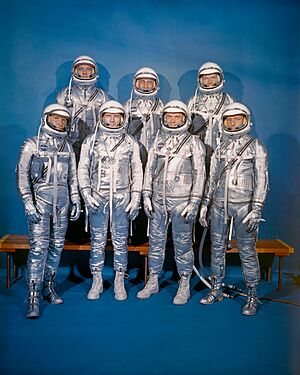
In 1957, the Soviet Union launched Sputnik 1, the first artificial satellite. This event made Americans worried about their technology. In response, President Dwight D. Eisenhower started the Space Race. National Aeronautics and Space Administration (NASA) was created in 1958 to develop space technology. One of its first big projects was Project Mercury, which aimed to send a person into Earth orbit and bring them back safely.
NASA looked for military test pilots to become the first astronauts. They reviewed hundreds of records. Candidates had to be under 40, have a college degree, and be 5 feet 11 inches (1.80 m) or shorter. Scott Carpenter met these requirements.
After many physical and psychological tests, Carpenter was chosen as one of the seven astronauts. The names of these seven men were announced on April 9, 1959. They were Carpenter, Gordon Cooper, John Glenn, Gus Grissom, Wally Schirra, Alan Shepard, and Deke Slayton. A few weeks later, they watched an Atlas rocket explode during a launch. This was a powerful reminder of the dangers of space travel.
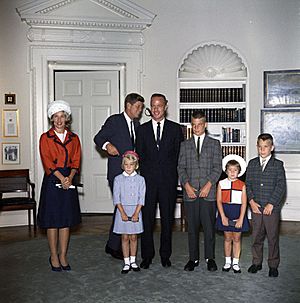
Aurora 7 Mission: A Trip to Orbit
The Flight and Experiments
Carpenter helped design the Mercury spacecraft, specializing in the navigation equipment. He was the backup pilot for John Glenn's historic flight in February 1962. You can hear Carpenter's voice saying "Godspeed, John Glenn" during Glenn's liftoff.
The next mission was supposed to be flown by Deke Slayton. However, Slayton was grounded due to health reasons. Carpenter, who had more training time in the simulators, was chosen to replace him. His mission, Mercury-Atlas 7, was focused on scientific experiments.
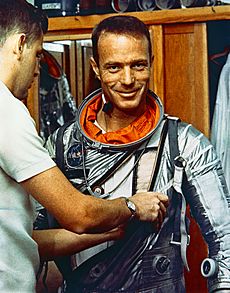
On May 24, 1962, Carpenter launched into space, with 40 million people watching on television. He solved the mystery of the "fireflies" that Glenn had seen. Carpenter realized they were tiny particles of frozen liquid from the spacecraft, which he called "frostflies."
During the flight, a part of the spacecraft called the pitch horizon scanner (PHS) had problems. This caused more fuel to be used than planned. Carpenter had to take manual control of the spacecraft for reentry. This meant he had to guide it back to Earth himself.
Landing and Rescue
Because of the PHS malfunction and the manual control, Aurora 7 landed about 250 miles (400 km) away from its target in the Atlantic Ocean. The flight lasted 4 hours and 56 minutes. During this time, Aurora 7 reached a maximum height of 166 miles (267 km) and traveled 81,355 miles (130,933 km).
There was a lot of worry about whether Carpenter was safe. News reporters shared the concern. Even though the spacecraft's beacon sent its exact location, and rescue ships were on their way, NASA didn't share this information with the news right away.
Knowing it might take time for the ships to arrive, Carpenter climbed out of his spacecraft and into his life raft. He released green dye into the water to help rescuers spot him. About 36 minutes after landing, he saw two aircraft, a P2V Neptune and a Piper Apache, which confirmed he had been found. Frogmen were parachuted down, and a helicopter eventually picked him up and took him to the aircraft carrier Intrepid.
After the Flight
After the flight, experts said the PHS malfunction was a "mission critical" problem. However, they noted that Carpenter "adequately compensated" for it. This showed how important human pilots were, especially when automatic systems failed.
Carpenter himself wrote that the system failures he faced would have led to the loss of the capsule if a human hadn't been aboard. He believed his reports led to important changes in spacecraft design and future flight plans. This shows that even with challenges, his mission provided valuable lessons for future space travel.
Exploring the Ocean: SEALAB
Underwater Living
Carpenter became very interested in underwater research. He got permission from NASA to join the U.S. Navy's SEALAB project, which involved living in underwater habitats. In 1964, he trained with the SEALAB team in Bermuda. During this time, he was injured in a motorcycle accident, which affected his arm and knee. These injuries meant he could not go on future spaceflights.
In August and September 1965, Carpenter spent 28 days living on the ocean floor in SEALAB II. This habitat was 205 feet (62 m) deep off the coast of California. The air inside the habitat was a special mix of helium, nitrogen, and oxygen. During this time, he had another minor injury when he was stung by a scorpion fish.
A very cool moment happened during SEALAB II: Carpenter had the first-ever conversation between someone in outer space (Gordon Cooper on his Gemini 5 mission) and someone living on the ocean floor!
Returning to NASA and Later Work
After his time with SEALAB, Carpenter returned to NASA. He worked as an Executive Assistant and helped develop underwater training for astronauts. This training was important for future spacewalks. He left NASA in 1967 and joined the Navy's Deep Submergence Systems Project. He became the Director of Aquanaut Operations for SEALAB III. When there was a problem with SEALAB III, he volunteered to help recover it.
Due to his injuries from the motorcycle accident and health issues from deep-sea diving, Carpenter was no longer able to go on space or deep-sea missions. He retired from the Navy in 1969 as a commander. After retiring, he started a company called Sea Sciences, Inc., which focused on using ocean resources and improving environmental health.
Life After Space and Sea
Author and Advocate
After leaving the Navy, Scott Carpenter became a consultant for companies that made sports and diving equipment. He also advised the film industry on space travel and oceanography. He gave many talks and appeared in TV documentaries about these subjects. He was involved in projects to control pests naturally and to turn waste into energy.
Along with the other Mercury Seven astronauts, he helped create the Astronaut Scholarship Foundation. This foundation provides scholarships for students studying science and engineering.
In 2003, he published his autobiography, For Spacious Skies, which he wrote with his daughter, Kristen Stoever. In 2008, he joined President George W. Bush and fellow astronaut Buzz Aldrin on the Intrepid, the same ship that had rescued him after his Aurora 7 flight. In 2012, he celebrated the 50th anniversary of John Glenn's mission with Glenn and other NASA staff.
Family Life
Scott Carpenter was married and had several children. He had five children with his first wife, Rene: Marc Scott, Kristen Elaine, Candace Noxon, Robyn Jay, and Timothy Kit (who died as a baby). He later had two more children, Matthew Scott and Nicholas Andre, with his second wife, Maria Roach. With his third wife, Barbara Curtin, he had a son named Zachary Scott. In 1999, he married his fourth wife, Patricia Barrett, and they lived in Vail, Colorado.
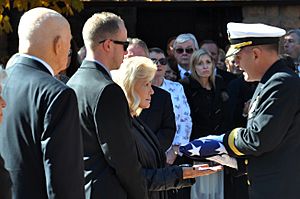
In September 2013, Carpenter suffered a stroke and was hospitalized. He passed away on October 10, 2013, at the age of 88. He was survived by his wife, four sons, two daughters, a granddaughter, and five step-grandchildren.
The Governor of Colorado ordered flags to be flown at half-mast in his honor. A memorial service was held, attended by many fellow astronauts, including John Glenn. His remains were cremated and buried on his family's ranch.
Interesting facts about Scott Carpenter
- As a student, Carpenter played the clarinet, was a cheerleader, and worked on the school newspaper.
- He became the first American astronaut to eat solid food in space.
- Carpenter met the famous ocean explorer Jacques Cousteau in 1963.
- He wrote two exciting science fiction novels, The Steel Albatross (1991) and Deep Flight (1994).
- When asked in 2012 what he wanted his legacy to be, Scott Carpenter simply replied: "I was an astronaut and an aquanaut."
Awards and Recognition
Scott Carpenter received many awards and honors for his service and achievements:
| Navy Astronaut Wings | ||
| Legion of Merit | Distinguished Flying Cross | NASA Distinguished Service Medal |
| Navy Unit Commendation | American Campaign Medal | World War II Victory Medal |
| China Service Medal | National Defense Service Medal with bronze star | Korean Service Medal with two battle stars |
| Republic of Korea Presidential Unit Citation | United Nations Korea Medal | Korean War Service Medal |
Civilian Awards
- University of Colorado Recognition Medal
- Collier Trophy
- New York City Gold Medal of Honor
- Elisha Kent Kane Medal
- Boy Scouts of America Silver Buffalo Award
Honors
Many places have been named in Scott Carpenter's honor:
- In 1962, Scott Carpenter Park and Pool were dedicated in Boulder, Colorado. The park has a 25-foot tall climbable rocket spaceship.
- Aurora 7 Elementary School in Boulder was named after his spacecraft.
- Scott Carpenter Middle School in Westminster, Colorado, and M. Scott Carpenter Elementary School in Old Bridge, New Jersey, were also named for him.
- The Scott Carpenter Space Analog Station, an underwater research station, was named in his honor in the 1990s, recognizing his SEALAB work.
Carpenter was inducted into several halls of fame:
- International Air & Space Hall of Fame in 2008
- International Space Hall of Fame in 1981
- National Aviation Hall of Fame in 2017
- U.S. Astronaut Hall of Fame in 1990 (along with the other Mercury Seven astronauts)
Books by Scott Carpenter
- We Seven: By the Astronauts Themselves, ISBN: 978-1439181034 (co-written with the other Mercury Seven astronauts).
- For Spacious Skies: The Uncommon Journey of a Mercury Astronaut, ISBN: 0-15-100467-6 (his autobiography, co-written with his daughter Kristen Stoever).
- The Steel Albatross, ISBN: 978-0831776084 (a science fiction thriller).
- Deep Flight, ISBN: 978-0671759032 (a follow-up science fiction thriller to The Steel Albatross).
See also
 In Spanish: Scott Carpenter para niños
In Spanish: Scott Carpenter para niños


